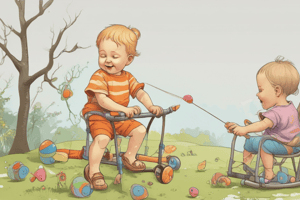Podcast
Questions and Answers
What is the main driving force of evolution according to Darwin and Wallace?
What is the main driving force of evolution according to Darwin and Wallace?
- Natural selection (correct)
- Genetic drift
- Sexual selection
- Mutation
How does natural selection operate?
How does natural selection operate?
- Through foresight and planning
- By favoring individuals randomly
- By directing conscious decision-making
- By differential success of individuals with heritable traits (correct)
What can natural selection lead to over many generations?
What can natural selection lead to over many generations?
- Speciation (correct)
- Random genetic patterns
- Increased mutation rates
- Decrease in species diversity
Why is it mentioned that natural selection does not involve conscious decision-making?
Why is it mentioned that natural selection does not involve conscious decision-making?
Which of the following is NOT one of the key components of natural selection?
Which of the following is NOT one of the key components of natural selection?
What is the role of variation in natural selection?
What is the role of variation in natural selection?
What is the primary function of selective pressures in an environment?
What is the primary function of selective pressures in an environment?
In which type of natural selection are individuals with extreme phenotypes at both ends of a trait distribution favored?
In which type of natural selection are individuals with extreme phenotypes at both ends of a trait distribution favored?
What happens to the frequency of a favored trait in directional selection?
What happens to the frequency of a favored trait in directional selection?
What is the outcome of stabilizing selection on a population?
What is the outcome of stabilizing selection on a population?
What is the main idea behind incremental change as discussed in the text?
What is the main idea behind incremental change as discussed in the text?
How is hereditary information transferred according to Pangenesis theory?
How is hereditary information transferred according to Pangenesis theory?
What did many biologists at the time reject as the mechanism for evolutionary change?
What did many biologists at the time reject as the mechanism for evolutionary change?
What did Gregor Mendel discover about traits through his plant breeding experiments?
What did Gregor Mendel discover about traits through his plant breeding experiments?
How did Mendel account for the appearance and disappearance of traits in his experiments?
How did Mendel account for the appearance and disappearance of traits in his experiments?
What concept combines Darwin's Natural Selection with Mendel's Genes?
What concept combines Darwin's Natural Selection with Mendel's Genes?
How is evolution by natural selection conceptualized in terms of changes in a population?
How is evolution by natural selection conceptualized in terms of changes in a population?
'Tinbergen’s Hypothesis' addresses which adaptation related to black-headed gulls and their nesting behavior?
'Tinbergen’s Hypothesis' addresses which adaptation related to black-headed gulls and their nesting behavior?
Flashcards
Natural selection
Natural selection
The main driving force of evolution, proposed by Darwin and Wallace.
Operation of natural selection
Operation of natural selection
It operates by differential success of individuals with heritable traits.
Speciation
Speciation
Natural selection can lead to the formation of new species over generations.
Natural selection vs. artificial selection
Natural selection vs. artificial selection
Signup and view all the flashcards
Key components of natural selection
Key components of natural selection
Signup and view all the flashcards
Role of variation in natural selection
Role of variation in natural selection
Signup and view all the flashcards
Selective pressures
Selective pressures
Signup and view all the flashcards
Disruptive selection
Disruptive selection
Signup and view all the flashcards
Directional selection
Directional selection
Signup and view all the flashcards
Outcome of stabilizing selection
Outcome of stabilizing selection
Signup and view all the flashcards
Incremental change
Incremental change
Signup and view all the flashcards
Pangenesis theory
Pangenesis theory
Signup and view all the flashcards
Rejection of Pangenesis
Rejection of Pangenesis
Signup and view all the flashcards
Mendel's discovery
Mendel's discovery
Signup and view all the flashcards
Mendel's hypothesis on traits
Mendel's hypothesis on traits
Signup and view all the flashcards
Modern Synthesis
Modern Synthesis
Signup and view all the flashcards
Changes in allele frequencies
Changes in allele frequencies
Signup and view all the flashcards
Tinbergen’s Hypothesis
Tinbergen’s Hypothesis
Signup and view all the flashcards




